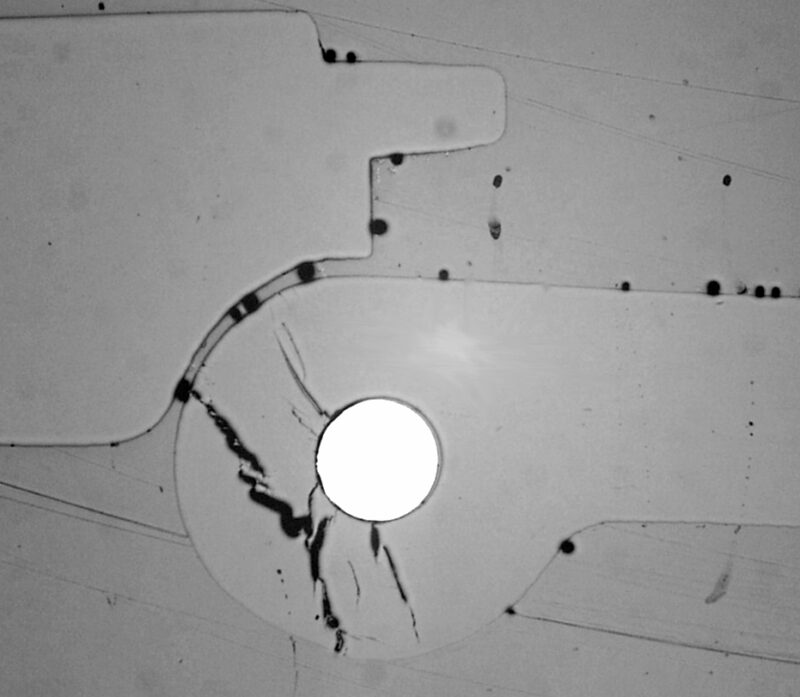This article originally appeared in Appliance Design Magazine – January 2006.
When a component failure occurs in service, the negative effects can extend well beyond the cost of replacing the piece of equipment. This is particularly true when user safety may be at risk. When a failure takes place, it is extremely important to approach the situation scientifically to elucidate the situation. The goal of a failure investigation is quite basic — to determine the nature and cause of the failure, to identify how and why the part failed.
Assessing the cause of the failure includes ascertaining both primary factors and contributing influences. Factors affecting product performance can be placed into four categories: material, component design, part processing/assembly, and service conditions in which the part is used. It is rare that a failure can be attributed to a single factor; instead, it is often the consequence of two or more contributing elements combining to create the failure. The key to the analysis, and the ultimate solution, is properly identifying all of the factors that played a role in the failure.
Failure analysis is the application of analytical observation and testing, guided by engineering practices, to the investigation of a failure within a part or assembly. A failure analysis provides information that assists in improving products through the revision of part design, material selection, fabrication/assembly techniques, and inspection and evaluation procedures. This is achieved by identifying systematic defects or flaws within a manufactured component. Conducting a failure analysis is like putting together a jigsaw puzzle. When the individual pieces are assembled, the picture becomes quite clear. The expression, “If you don’t know how it broke, you don’t know how to fix it,” accurately and succinctly states the importance of conducting a failure analysis.
While common sense and historical insight are essential parts of a failure analysis, pet theories and conjecture must not be allowed to cloud the judgment of the investigator. It is very important that a failure analysis be approached with an open mind, without prejudice or predisposition. Such impartiality is sometimes best accomplished by utilizing the services of a neutral third party, which has no stake in the results. No matter who performs the failure analysis, it is imperative that it is based on a deliberate methodology, using sound engineering practices and analytical data. It must be remembered that the goal of the failure analysis is to solve a problem, not conduct a research study or generate data.
The following case study illustrates the value and methodology used in performing a failure analysis. A group of cases used in a portable personal medical monitor was received for failure analysis, as the parts had cracked while in service. A group of cases used in a portable personal medical monitor was received for failure analysis, as the parts had cracked while in service. A comprehensive failure analysis should begin by collecting the relevant background information. In this investigation, the submitted parts represented a limited release design modification within the 9 V battery door hinge. The cases were designed using an interference fit between the hinge pin and the hinge holes. Specifically, a 0.0495 in. hinge pin was used in conjunction with a 0.0480 in. diameter hole.

Photomicrograph showing a cross-section prepared through a cracked hinge.
The individual components making up the monitor case were injection molded from an unfilled flame-retardant grade of polycarbonate/polyethylene terephthalate blend. In addition to the failed monitor cases, a typical sample of molding resin was also received for comparison purposes. Speculation surrounding the failure suggested that aggressive cleaning agents had been used on the parts that had resulted in chemical attack of the plastic resin and subsequent cracking. The monitor cases were initially examined visually and at low magnification with the aid of an optical stereomicroscope. This type of inspection is essential in the characterization of the failure mode and the selection of samples for further evaluation. The visual and microscopic examinations revealed generally similar features on all of the submitted cases. Numerous cracks were evident on the battery door hinge, within both the bosses on the case body and the door bosses.
The failure analysis included:
- Visual and microscopic examination
- Scanning electron microscopy (SEM)
- Fourier transform infrared spectroscopy (FTIR)
- Differential scanning calorimetry (DSC)
- Thermogravimetric analysis (TGA)
- Energy dispersive X-ray spectroscopy (EDS)
By conducting a failure analysis on the cracked monitor cases that failed in service, it was possible to identify the nature and cause of the problem. The evaluation identified the mode of the failure as creep associated with the interference between the hinge pin and hinge boss, as well as the cause of the failure, namely the substantial level of molecular degradation resulting from the molding of the parts. This information was used to alter the design and molding, both to reduce the level of interference stress and to improve the inherent mechanical properties of the formed parts. The full value of performing the failure analysis cannot be completely calculated. However, it appears likely that had the failures been dismissed as chemical attack by an unknowing user, further product field failure would have been likely.
